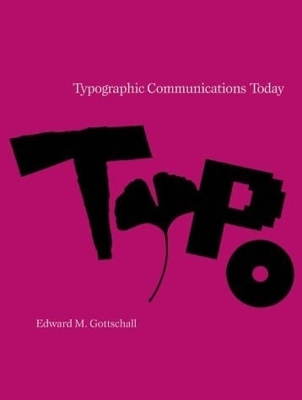
Typographic Communications Today
Seiten
1989
MIT Press (Verlag)
978-0-262-07114-7 (ISBN)
MIT Press (Verlag)
978-0-262-07114-7 (ISBN)
- Titel z.Zt. nicht lieferbar
- Versandkostenfrei
- Auch auf Rechnung
- Artikel merken
With over 900 illustrations, more than 500 in color, it is an essential reference book for graphic artists and designers and for those who, regardless of profession are involved in design choices.
Suddenly, the universe of people making typographical decisions has expanded. Effective visual communication through the informed manipulation of the size and style of type, its placement on a two dimensional surface, its integration with graphic material, and the quality of its reproduction is within reach of anyone who has a computer. Typographic Communications Today places this phenomenon in historical perspective, covering the whole of 20th century graphic design. With over 900 illustrations, more than 500 in color, it is an essential reference book for graphic artists and designers and for those who, regardless of profession are involved in design choices. It clarifies the options available in this new era of print while at the same time examining the new technologies in the context of art history. The numerous quotations by first rate designers make this a treasury of good thinking about the hows and whys of typographic design. Types are displayed and grid systems employed as they are being discussed. Gottschall's lively commentary examines the many typographic solutions designers have evolved for communication problems, beginning with the creative solutions devised by artists, painters, architects, poets and concluding with the new opportunities and challenges posed by computers and laser technology.
Several chapters focus on how these technologies have changed the ways typefaces are being designed and used. Gottschall explains how terminals, output devices, networks, scanners, and software have revolutionized the world of typesetting and given graphic designers a whole new set of tools, freedoms, and restrictions. The chapter "Bits, Bytes, and Typographic Design," for example, offers a state of the art review of keyboarding on terminals, image scanning, electronic filing, and networking. Not only does Gottschall discuss the role of personal computers and word processing software, he also reviews the packages and languages available from all of the major corporate players Apple, Xerox, Wang, IBM AT&T, Interleaf, and many others and evaluates the future of such possibilities as X-ray chip etching. Edward M. Gottschall is Vice Chairman of International Typeface Corporation and Editor of U&lc magazine.
Suddenly, the universe of people making typographical decisions has expanded. Effective visual communication through the informed manipulation of the size and style of type, its placement on a two dimensional surface, its integration with graphic material, and the quality of its reproduction is within reach of anyone who has a computer. Typographic Communications Today places this phenomenon in historical perspective, covering the whole of 20th century graphic design. With over 900 illustrations, more than 500 in color, it is an essential reference book for graphic artists and designers and for those who, regardless of profession are involved in design choices. It clarifies the options available in this new era of print while at the same time examining the new technologies in the context of art history. The numerous quotations by first rate designers make this a treasury of good thinking about the hows and whys of typographic design. Types are displayed and grid systems employed as they are being discussed. Gottschall's lively commentary examines the many typographic solutions designers have evolved for communication problems, beginning with the creative solutions devised by artists, painters, architects, poets and concluding with the new opportunities and challenges posed by computers and laser technology.
Several chapters focus on how these technologies have changed the ways typefaces are being designed and used. Gottschall explains how terminals, output devices, networks, scanners, and software have revolutionized the world of typesetting and given graphic designers a whole new set of tools, freedoms, and restrictions. The chapter "Bits, Bytes, and Typographic Design," for example, offers a state of the art review of keyboarding on terminals, image scanning, electronic filing, and networking. Not only does Gottschall discuss the role of personal computers and word processing software, he also reviews the packages and languages available from all of the major corporate players Apple, Xerox, Wang, IBM AT&T, Interleaf, and many others and evaluates the future of such possibilities as X-ray chip etching. Edward M. Gottschall is Vice Chairman of International Typeface Corporation and Editor of U&lc magazine.
Edward M. Gottschall is Vice Chairman of International Typeface Corporation and Editor of U&lc magazine.
| Erscheint lt. Verlag | 10.2.1989 |
|---|---|
| Reihe/Serie | The MIT Press |
| Verlagsort | Cambridge, Mass. |
| Sprache | englisch |
| Maße | 272 x 363 mm |
| Gewicht | 2109 g |
| Themenwelt | Kunst / Musik / Theater ► Design / Innenarchitektur / Mode |
| Informatik ► Grafik / Design ► Desktop Publishing / Typographie | |
| ISBN-10 | 0-262-07114-2 / 0262071142 |
| ISBN-13 | 978-0-262-07114-7 / 9780262071147 |
| Zustand | Neuware |
| Haben Sie eine Frage zum Produkt? |
Mehr entdecken
aus dem Bereich
aus dem Bereich


